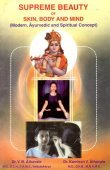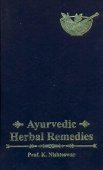Varṇya, Varnya: 9 definitions
Introduction:
Varṇya means something in Hinduism, Sanskrit, Hindi. If you want to know the exact meaning, history, etymology or English translation of this term then check out the descriptions on this page. Add your comment or reference to a book if you want to contribute to this summary article.
Alternative spellings of this word include Varny.
In Hinduism
Ayurveda (science of life)
Cosmetics, Perfumery, Skin care and other Ayurvedic Beauty treatments
Source: Ancient Science of Life: Critical review of Ayurvedic Varṇya herbsVarṇya (वर्ण्य) refers to medicinal herbs that promote “skin whitening” (whatever brings softness and beauty to skin along with enhancement of complexion, radiance or luminescence is termed as varṇya).—In Ayurveda, process of formation of skin in foetus is attributed to pāka of rakta-dhātu. Agni-mahābhūta is said to be at the root of varṇa-utpatti (skin colour formation) and pitta being the main seat of agni is responsible for the same. Prabhā or maintenance of body complexion is one of the functions of pitta and bhrājaka-pitta seated in the skin radiates the glow of one’s natural complexion that is expressed through varṇa. Hence the herbs which alleviate pitta, rakta in general either acting through their rasa, vipāka or prabhāva are considered as varṇya.
Ayurvedic literature describes over 200 herbs and minerals to maintain and enhance the beauty of the skin. A few herbs:—
- Śveta Candana (Santalum album),
- Madhuyaṣṭi (Glycyrrhiza glabra),
- Mañjiṣṭhā (Rubia cordifolia),
- Nāgakesara (Mesua ferrea),
- Padmaka (Prunus cerasoides),
- Śārivā (Hemidesmus indica),
- Uṣīra (Vetiveria zizanoides),
- Lodhra (Symplocos racemosa),
- Kuṣṭha (Saussurea lappa),
- Kesar (Crocus sativus),
- Haridrā (Curcuma longa),
- Dāruharidrā (Berberis aristata),
- Mustaka (Cyperus rotundus),
- Nimba (Azadirachta indica, commonly called neem),
- Khādira (Acacia catechu),
- Āmalakī (Phyllanthus emblica),
- Harītakī (Terminalia chebula),
- Śuṇṭhi (Zingiber officinale),
- Padma (Nelumbo nucifera).
Most of the herbs evaluated above for their action upon skin whitening are largely described as varṇya drugs in Ayurveda. A few among them act indirectly as varṇya by alleviating rakta and pitta doṣa. [...] Drugs evaluated here are described with varṇya use in Ayurveda but are being used primarily for ailments rather than as skin applications. We found all the herbs evaluated here to act as varṇya directly or indirectly as per Ayurveda and to inhibit tyrosinase enzyme activity.
Unclassified Ayurveda definitions
Source: Wisdom Library: Āyurveda and botanyVarṇya (वर्ण्य) is the Sanskrit name for a group of medicinal plants, classified as “improving the complexion”, and originally composed by Caraka in his Carakasaṃhitā sūtrasthāna IV. It is a technical term used throughout Āyurveda. The name is derived from the word varṇa, translating to “color”. Examples of plants pertaining to this category include Candana (Pterocarpus santalinus), Tuṅga (Calophyllum inophyllum), Mañjiṣṭhā (Rubia cordifolia) and Śarivā (Hemidesmus indicus). The collection of herbs named Varṇya is one of the fifty Mahākaṣāya.
Source: gurumukhi.ru: Ayurveda glossary of termsVarṇya (वर्ण्य):—Complexion promoters

Āyurveda (आयुर्वेद, ayurveda) is a branch of Indian science dealing with medicine, herbalism, taxology, anatomy, surgery, alchemy and related topics. Traditional practice of Āyurveda in ancient India dates back to at least the first millenium BC. Literature is commonly written in Sanskrit using various poetic metres.
Languages of India and abroad
Sanskrit dictionary
Source: DDSA: The practical Sanskrit-English dictionaryVarṇya (वर्ण्य).—a.
1) To be described; (often used in rhetorical works like prakṛta or prastuta q. v.).
2) Relating to colour.
-rṇyam Saffron.
Source: Cologne Digital Sanskrit Dictionaries: Cappeller Sanskrit-English DictionaryVarṇya (वर्ण्य).—[adjective] to be painted or described.
Source: Cologne Digital Sanskrit Dictionaries: Monier-Williams Sanskrit-English Dictionary1) Varṇya (वर्ण्य):—[from varṇ] 1. varṇya mfn. to be (or being) delineated or described or pictured, describable, [Sāhitya-darpaṇa]
2) [from varṇ] 2. varṇya mfn. relating to or useful for or giving colour, [Suśruta]
3) [v.s. ...] n. saffron, [cf. Lexicographers, esp. such as amarasiṃha, halāyudha, hemacandra, etc.]
[Sanskrit to German]
Sanskrit, also spelled संस्कृतम् (saṃskṛtam), is an ancient language of India commonly seen as the grandmother of the Indo-European language family (even English!). Closely allied with Prakrit and Pali, Sanskrit is more exhaustive in both grammar and terms and has the most extensive collection of literature in the world, greatly surpassing its sister-languages Greek and Latin.
Hindi dictionary
Source: DDSA: A practical Hindi-English dictionaryVarṇya (वर्ण्य) [Also spelled varny]:—(a) fit to be described/narrated; -[viṣaya] the theme; topic of description/treatment.
...
Nepali dictionary
Source: unoes: Nepali-English DictionaryVarṇya (वर्ण्य):—adj. 1. → वर्णनीय [varṇanīya ] ; 2. presented;
Nepali is the primary language of the Nepalese people counting almost 20 million native speakers. The country of Nepal is situated in the Himalaya mountain range to the north of India.
See also (Relevant definitions)
Query error!
Full-text (+25): Caturvarnya, Avarnya, Varnyasama, Vinirvarn, Avarnyasama, Avarniyam, Varniyam, Vyavarn, Nirvarn, Varny, Sariva, Ushira, Rubia cordifolia, Berberis aristata, Cinnamomum zeylanicum, Dadru, Shvitra, Pippalu, Saussurea lappa, Cinnamomum tamala.
Relevant text
Search found 24 books and stories containing Varṇya, Varnya; (plurals include: Varṇyas, Varnyas). You can also click to the full overview containing English textual excerpts. Below are direct links for the most relevant articles:
Bhagavad-gita (with Vaishnava commentaries) (by Narayana Gosvami)
Verse 4.13 < [Chapter 4 - Jñāna-Yoga (Yoga through Transcendental Knowledge)]
Amarakoshodghatana of Kshirasvamin (study) (by A. Yamuna Devi)
Daily Life (3): Perfumes < [Chapter 3 - Social Aspects]
Standardization of complexion promoters: Yashtimadhu and Manjishta < [Volume 7, Issue 2: March - April 2020]
Critical study of medicinal plants in Durga Saptasati. < [Volume 8, Issue 1: January - February 2021]
Critical Review of Charaka Samhita: Varnya - Ahara, Vihara, Aushdha. < [Volume 11, Issue 3: May-June 2024]
Critical review of Ayurvedic Varṇya herbs and their tyrosinase inhibition effect < [Volume 35 (issue 1), Jul-Sep 2015]
A re-classification of ayurvedic herbs indicated in skin diseases (kustha) < [Volume 16 (issue 4), Apr-Jun 1997]
Utility of Manjisthadi Lepa in Soft Tissue Inflammation < [Volume 28 (issue 3), Jan-Mar 2009]
Bhakti-rasamrta-sindhu (by Śrīla Rūpa Gosvāmī)
Verse 2.3.47 < [Part 3 - Involuntary Ecstatic Expressions (sattvika-bhāva)]
AYU (Journal of Research in Ayurveda)
In vitro study on anti-oxidant and anti-inflammatory properties of Varnya Mahakashaya Dashemani (aqueous extract): A polyherbal formulation < [Volume 39 (2); 2018 (Apr-Jun)]
Clinical evaluation of Varnya Gana Lepa in Vyanga (melasma) < [Volume 36 (2); 2015 (Apr-Jun)]
Clinical study of Manjishthadi Ghrita in vrana ropana < [Volume 32 (1); 2011 (Jan-Mar)]
Related products

